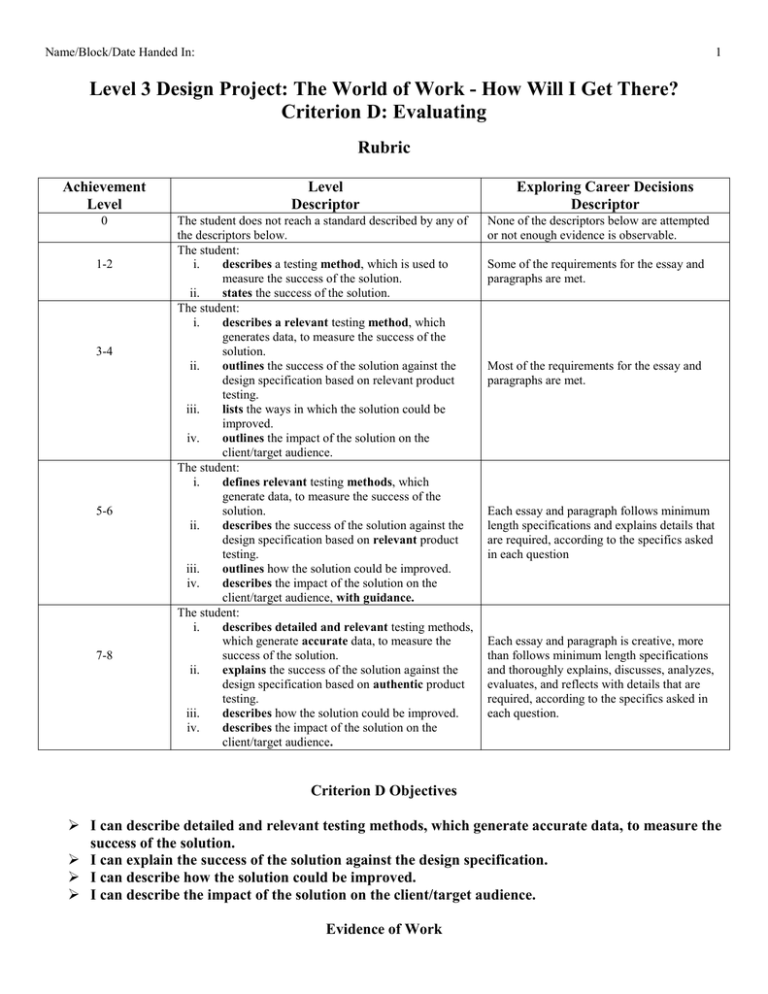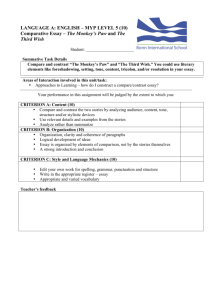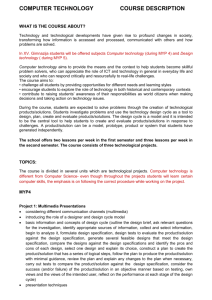Level 3 Design Project: The World of Work
advertisement

Name/Block/Date Handed In: 1 Level 3 Design Project: The World of Work - How Will I Get There? Criterion D: Evaluating Rubric Achievement Level Level Descriptor 0 The student does not reach a standard described by any of the descriptors below. The student: i. describes a testing method, which is used to measure the success of the solution. ii. states the success of the solution. The student: i. describes a relevant testing method, which generates data, to measure the success of the solution. ii. outlines the success of the solution against the design specification based on relevant product testing. iii. lists the ways in which the solution could be improved. iv. outlines the impact of the solution on the client/target audience. The student: i. defines relevant testing methods, which generate data, to measure the success of the solution. ii. describes the success of the solution against the design specification based on relevant product testing. iii. outlines how the solution could be improved. iv. describes the impact of the solution on the client/target audience, with guidance. The student: i. describes detailed and relevant testing methods, which generate accurate data, to measure the success of the solution. ii. explains the success of the solution against the design specification based on authentic product testing. iii. describes how the solution could be improved. iv. describes the impact of the solution on the client/target audience. 1-2 3-4 5-6 7-8 Exploring Career Decisions Descriptor None of the descriptors below are attempted or not enough evidence is observable. Some of the requirements for the essay and paragraphs are met. Most of the requirements for the essay and paragraphs are met. Each essay and paragraph follows minimum length specifications and explains details that are required, according to the specifics asked in each question Each essay and paragraph is creative, more than follows minimum length specifications and thoroughly explains, discusses, analyzes, evaluates, and reflects with details that are required, according to the specifics asked in each question. Criterion D Objectives I can describe detailed and relevant testing methods, which generate accurate data, to measure the success of the solution. I can explain the success of the solution against the design specification. I can describe how the solution could be improved. I can describe the impact of the solution on the client/target audience. Evidence of Work Name/Block/Date Handed In: 2 Classwork and Homework Directions: You need to evaluate two things: (1) how your product turned out and (2) how you felt about your use of the IB Design Cycle (by specifying each individual criterion – A, B, C, and D). Step 1 – Reflect, analyze, and evaluate the product/solution. 1. In an essay of ½ page or longer, reflect, analyze, and evaluate how your product turned out. What are its strengths? What did you do best? What are its OFI’s (opportunities for improvement or what would you improve on)? Compare your product to the tests/checklists you created in Criteria A and B and to the plan you created in Criterion C. Consider whether your product is successful based on the checklist. For example, consider its pros and cons based on each item on your checklist and how they were applied or modified for your product. Also, analyze both your own views on its outcome and the views of the intended user (your audience). Cite specifics; please do not just write general comments like “good,” “okay,” “bad,” “better,” etc. Step 2 – Reflect, analyze, and evaluate the use of the design cycle, by each individual criterion (A, B, C, and D). 2. In a paragraph of five or more sentences, reflect, analyze, and evaluate your use of Criterion A: Inquiring and analyzing - of the design cycle. Did you thoroughly detail both yours and teachers expectations? How do you feel about your time, effort, and work of finding, collecting, and analyzing your research? How did you know that your sources were valid and reliable? What are your strengths for Criterion A? What did you do best? What are your OFI’s (opportunities for improvement)? What would you do differently if you had to do it over? 3. In a paragraph of five or more sentences, reflect, analyze, and evaluate your use of Criterion B: Developing ideas - of the design cycle. How do you feel about your chart (checklist), comparison, and analysis of your selected three items or products? Did your diagram/outline give you a preview of what your multimedia or web design presentation may look like? What are your strong points with Criterion B? What did you did you like the best? What would you do differently if you had to do it over? 4. In a paragraph of five or more sentences, reflect, analyze, and evaluate your use of Criterion C: Creating the solution - of the design cycle. How do you feel about your time, effort, and work that you invested with completing your plan for your multimedia or web design presentation? What are its strengths? What did you do best? What are its OFI’s (opportunities for improvement or what would you improve on)? In Step 1, Question one of this Criterion D Evidence of Work document, you evaluated your movie or web design presentation. What would you do differently if you had to do your presentation over? 5. In a paragraph of five or more sentences, reflect, analyze, and evaluate your use of Criterion D: Evaluating - of the design cycle. Of course, it’s the criterion of the design cycle that you are completing now. Refer to the rubric for Criterion D at the beginning of this document. Reflect on your essay (#1) about evaluating your product. Also, reflect on these four paragraphs (numbers 2-5) about your evaluation of your use of criteria A, B, C, and now, D.? How was Criterion D different from criteria A, B, and C? What are your suggestions for improvement for Criterion D? .







